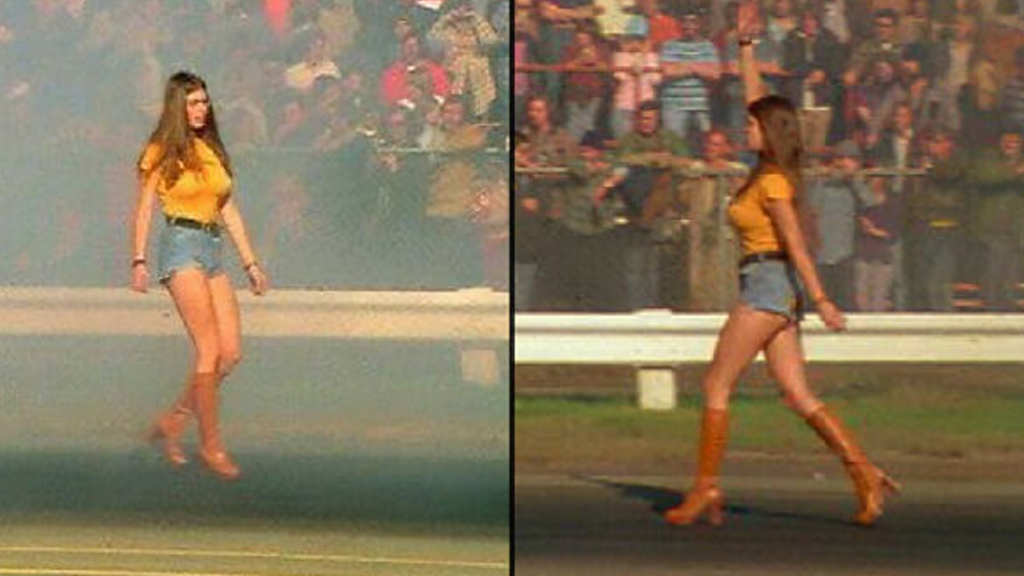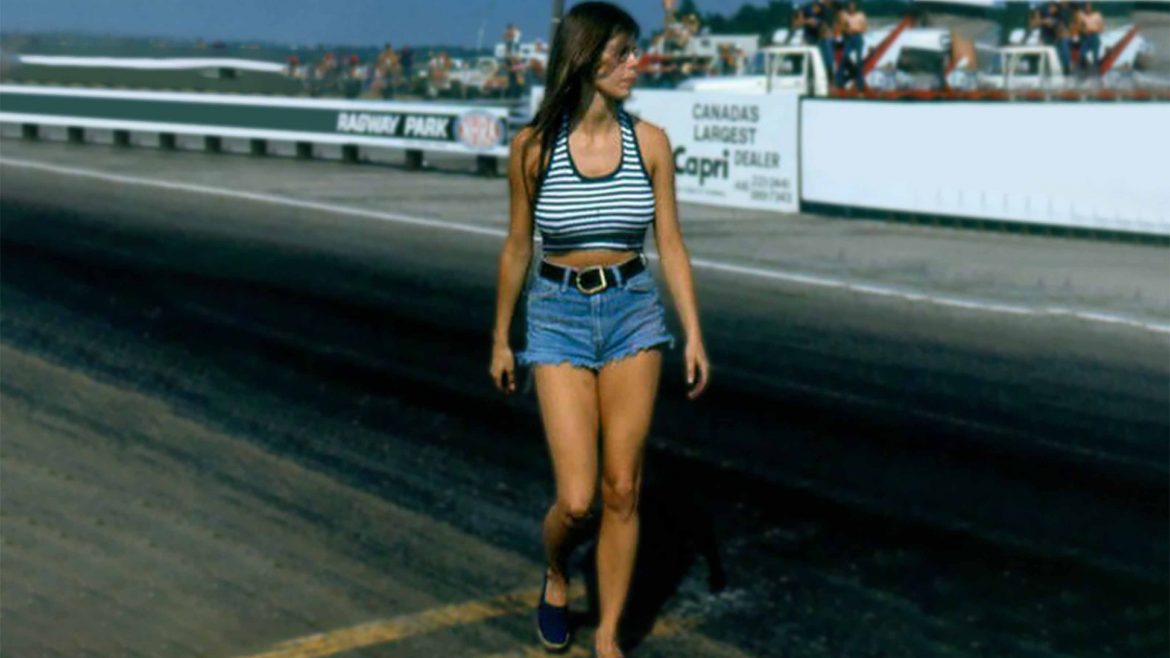As humans, we think in stories rather than facts, statistics and equations, and the simpler the story, the better. But the thing about stories is that once they are born, you cannot control their fate. Just like children, once they enter the world, they assume an independent identity that may or may not resemble their origin. Jungle Jim and Jungle Pam are the protagonists of one such story.
Disclaimer: For those of you who are coming across these names for the first time and are immediately forming an association with the cutesy couple – Jim and Pam – from the American mockumentary sitcom The Office, I must politely yet persistently ask you to stop right there. Not because that would be anachronistic but because you cannot possibly imagine the doe-eyed Pam Beesly in a tight revealing top with no bra on and a pair of booty shorts, backing up flashy race cars. Okay, maybe you can but please don’t.
In the 1960s, drag racing fans were going crazy for Funny Cars. These cars combined powerful engines with lightweight bodies, creating the perfect recipe for speed. Funny Cars were all about going fast and looking cool while doing it, which is what attracted both drivers and fans. And Jim Liberman, better known as Jungle Jim was, hands-down, one of the most popular Funny Car drivers of the era.
Jungle Jim had cracked the code- ‘Sex and speed sells’. While he seemed to have harnessed speed, what he required to sell it better was sex appeal. This is where Jungle Pam came into the picture.

In 1972, Pamela Hardy was merely 18 years old and on the cusp of her high school graduation when she met Jim Liberman. Lieberman was cruising through the streets of West Chester in his yellow Corvette when he laid eyes on Pam. And boy was he awe-struck by her stark beauty! A chance introduction soon plunged her into the whirlwind world of drag racing. Her college plans were shelved, her bags were packed, and she embarked on an adventure that entailed traversing the nation’s drag racing circuit.
Pam Hardy’s drag racing experience was virtually nonexistent, much less being part of a pit crew. Nevertheless, Lieberman enlisted her assistance on the track. Known for his flamboyant and ostentatious drag car exhibitions, Lieberman found in Hardy the perfect embodiment of glitz and glamour. Her initial role saw her as Lieberman’s “backup girl,” tasked with positioning his 1973 Chevrolet Vega on the track before each race. Lieberman craved the spotlight, yearning for all eyes to be fixated on him as he slipped into his Funny Car’s driver’s seat. Who better to command attention on the track than a striking young woman?
With her signature halter tops, micro-mini shorts and risqué hijinks on the track, Pam Hardy soon captured the wild imaginations of enthusiasts as Lieberman had envisioned. Her name alone evoked anticipation and excitement among her male admirers. She transformed the seemingly mundane task of guiding a car a few feet backwards into a captivating spectacle that had the audience members most positively titillated, earning her the moniker ’Jungle Pam’. But Pam was more than just a ‘racetrack bombshell’ or ‘trophy girl’ brightening up the pits. She soon transitioned to a more hands-on role, actively assisting the crew with tasks ranging from topping off the engine block with water to repacking the parachute and adding oil to the car. In her own right, she garnered a substantial fan base, distinct from Lieberman’s.

As a team, Jungle Jim and Jungle Pam were the hottest and fastest thing on and off the track. During a period where drivers had the liberty to carve their own unique brand, the emergence of the Jungle Pam phenomenon was a masterstroke by Lieberman, elevating the profile of both his team and the entire realm of Funny Car racing.
The popular narrative around Jungle Pam positions her as an eye-candy, grabbing attention on the asphalt with her skimpy clothes and go-go boots. But that story is too one-dimensional. While her role on the track is largely seen as a supporting act, Jungle Pam was not a phenomenal marketing manoeuvre. She was a phenomenon. While her sartorial choices and exaggerated gyrations grabbed one too many eyeballs, Jungle Pam was not oblivious to the tremendous potential that this kind of attention could unleash. Nor was she the only one.
If Jungle Jim was the poster child of Funny Car Racing, Jungle Pam was the poster girl. We can dive into the politics of both these terms, flirt with semantics to highlight the inherent misogyny or directly reach the conclusion that both these tags elicit very different reactions- one positive, other not-so-positive. The agency that was sanctioned to Jungle Pam was limited but enough to get the dialogue started about the role of women on the tracks.
The National Hot Rod Association (NHRA) Drag Racing has witnessed significant contributions from several remarkable women, including Linda Vaughn, known as Ms Hurst Golden Shifter, who much like Pam, leveraged her charm and talent to create a unique space for herself in the drag racing circuit. Shirley Muldowney, known as the ‘First Lady of Drag Racing’ made history in 1965 when she became the first woman to earn a dragster licence from the NHRA. She was also the first person to win three NHRA World Championships. Other iconic figures like Carol ‘Bunny’ Burkett, Angelle Sampey, Brittany Force, and Erica Enders, among others, have redefined the common perception of women in motorsport.

By performing along the male gaze, Jungle Pam actually subverted it and created an alternate space for women in the male-dominated sport. She was on magazine covers, spicy posters, and forever imprinted in popular imagination, carving a niche for herself beyond Jungle Jim.
The golden era, however, was not destined to last. As drag racing surged in popularity, it simultaneously witnessed a tightening of regulations. Rules were imposed, curtailing the exuberant showmanship that had become Lieberman’s hallmark. This regulatory shift left Pam without a defined role on the team. Concurrently, the rigours of life on the road began to strain her relationship with Jim.
In the absence of Pam, and with new constraints on the stunts he relished, Lieberman’s ardour for drag racing appeared to wane. His once-thriving career experienced a palpable slowdown. For Lieberman, his ideal world was one replete with daring feats, abbreviated shorts, and halter tops – all integral to his performance. Deprived of these elements, he continued to race, but the fervour had dissipated.
Tragically, in 1977, his prized Corvette collided with a bus, an accident unrelated to racing, claiming his life at the tender age of 31. That prompted Pam to exit from the drag racing world. The story came full circle- Pam Hardy who became Jungle Pam reverted to being Pam Hardy.
In the wake of her exit from the drag racing limelight, Hardy embraced a life of quiet normalcy. Yet, she has diligently strived to preserve the memories of Jungle Jim Lieberman and that remarkable era of Funny Car racing. She continues to make appearances in the media and at National Hot Rod Association (NHRA) events, where she graciously signs autographs and keeps the spirit of her iconic partner alive.



